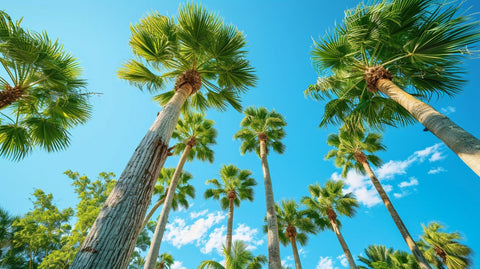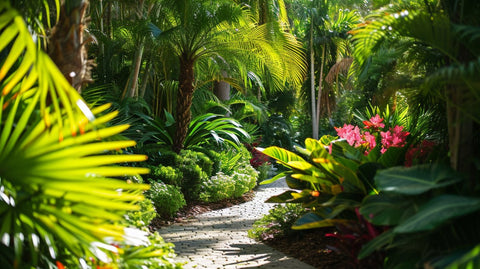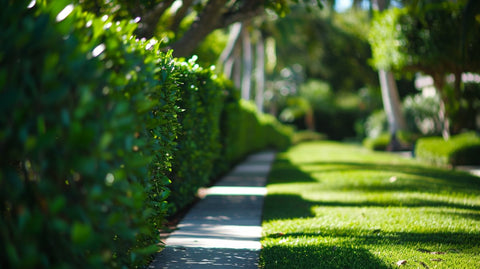In the lush landscapes of Florida, palm trees stand tall and proud, adding a touch of tropical paradise to the scenery. From the iconic Sabal palms to the lesser-known Ruffled fan palms, Florida boasts a wide variety of palm tree species that enhance the state's natural beauty. In this article, we will take a closer look at the different types of palm trees found in Florida, their unique characteristics, and their significance in the state's history and economy.
I. Introduction

A Brief history of palm trees in Florida
Florida's palm tree legacy dates back centuries. These towering symbols of the tropics were not indigenous to the state but were introduced by Spanish explorers during the 16th century. The explorers were captivated by the beauty and usefulness of palm trees and brought various species with them to Florida. Over time, these palm trees found a welcoming environment in the warm and sunny climate, establishing themselves as an integral part of the state's natural landscape.
B Importance of palm trees in Florida's landscape and economy
Palm trees play a crucial role in maintaining Florida's unique and diverse environment. Their lush foliage and distinctive shapes create stunning vistas that attract tourists from around the world. Additionally, palm trees provide shelter and food for a diverse array of wildlife, making them vital to the state's ecological balance.
Moreover, palm trees contribute significantly to Florida's economy. The tourism industry, which heavily relies on the state's natural beauty, is greatly influenced by the presence of palm trees. Many visitors associate Florida with its iconic palm-lined beaches and picturesque landscapes, which attract millions of tourists each year. Additionally, the palm tree industry generates revenue through the cultivation and sale of palm tree products, including landscaping services, palm fronds, and seeds.
II. Native Palm Trees in Florida
A. Sabal Palms (Sabal Palmetto)

1. Characteristics and appearance
Sabal palms, also known as Cabbage palms, are Florida's state tree and one of the most iconic palm tree species in the region. These majestic trees can reach heights of up to 80 feet and feature a single trunk with a crown of fan-shaped fronds that gracefully sway in the breeze. The trunks are grayish-brown and are adorned with distinctive diamond-shaped patterns formed by the leaf scars.
2. Geographic distribution
Sabal palms can be found throughout the state of Florida, particularly in coastal regions and wetland areas. They have adapted well to Florida's sandy soil and are often seen dotting the landscape, lending a touch of natural elegance to the surroundings.
3. Uses and significance
Sabal palms have served numerous purposes throughout Florida's history. Native American tribes used various parts of the tree for food, shelter, and medicine. The trunks provided sturdy construction material, while the leaves were weaved into baskets, mats, and roof thatching. Today, Sabal palms are highly valued for their ornamental and landscaping purposes, adding grace and charm to both residential and commercial properties.
B. Cabbage Palms (Sabal palmetto)

1. Description and features
Cabbage palms, also known as Sabal palms, are closely related to the Sabal palms described above. They are characterized by their straight trunks and clusters of large, fan-shaped fronds that form a dense canopy. The fronds are a vibrant green color and can grow up to 10 feet in length.
2. Habitat and range
Cabbage palms thrive in a variety of habitats, including wetlands, hammocks, and coastal areas. They are extremely versatile and can tolerate both drought and flooding, making them an ideal choice for Florida's unpredictable climate. These native palms can be found throughout the state, from the panhandle to the Florida Keys.
3. Cultural and historical importance
Cabbage palms have played a significant role in Florida's history and culture. Native American tribes utilized the trunks of these trees for building houses, crafting tools, and making canoes. The heart of the cabbage palm was also valued as a food source and was often used in traditional recipes. Today, these palms are beloved by Floridians and are frequently used in landscaping projects to provide shade and aesthetic appeal.
III. Popular Non-native Palm Trees in Florida
A. Canary Island Date Palms (Phoenix canariensis)
1. Identification and characteristics
Canary Island Date palms are known for their majestic appearance and towering height. These graceful palms can reach up to 60 feet in height and have a distinctive crown of feathery, arching fronds. The trunks of Canary Island Date palms are covered in a unique crisscross pattern created by the fallen fronds.
2. Preferred habitat and cultivation
Canary Island Date palms thrive in warm and sunny climates, making them well-suited to Florida's tropical environment. They are commonly found in urban and suburban areas, lining streets and adorning public parks. These palms prefer well-drained soil and are relatively low-maintenance, making them a popular choice for landscaping projects.
3. Common uses and benefits
Canary Island Date palms are highly valued for their ornamental appeal. Their striking silhouette and lush foliage make them a favored choice for landscape designers looking to create a luxurious, Mediterranean-inspired ambiance. Additionally, the fronds of these palms are often used in the production of palm hats, fans, and other decorative crafts.
B. Queen Palms (Syagrus romanzoffiana)

1. Appearance and distinctive traits
Queen palms are known for their graceful and elegant appearance. These palms have slender trunks and a canopy of feathery green fronds. The fronds are about 10 to 15 feet in length and form a semi-circular shape, creating a cascading effect.
2. Suitable environments and care
Queen palms thrive in warm and tropical regions, making them an excellent choice for Florida's climate. They prefer well-drained soil and thrive in full sun exposure. These palms require regular watering and benefit from periodic fertilization to maintain their vibrant green foliage.
3. Landscape and ornamental uses
Queen palms are commonly used in landscaping projects to add a touch of sophistication and tropical beauty. Their graceful appearance makes them a popular choice for lining driveways, creating focal points, or enhancing the aesthetics of outdoor spaces. They are often planted in clusters to create a lush and visually appealing backdrop.
IV. Cold-hardy Palm Trees in Florida
A. Windmill Palms (Trachycarpus fortunei)

1. Features and morphology
Windmill palms are renowned for their unique and distinctive appearance. These palms have slender trunks covered in a deep brown fiber, resembling the texture of a windmill. The fronds of the Windmill palm are fan-shaped and can reach lengths of up to 3 feet.
2. Climate preferences and adaptability
Windmill palms are prized for their cold hardiness, making them an excellent choice for Florida's varying climate. They can tolerate temperatures as low as 10 degrees Fahrenheit and are often seen thriving in regions with mild and moderate winters. These palms prefer well-draining soil and require regular watering.
3. Cold protection methods
In areas where temperatures drop significantly, providing additional cold protection to Windmill palms is recommended. This can be achieved by wrapping the trunk with burlap or using protective coverings during periods of frost. Furthermore, placing a layer of mulch around the base of the tree can help retain moisture and protect the roots from freezing.
B. European Fan Palms (Chamaerops humilis)

1. Description and appearance
European Fan palms, also known as Mediterranean Fan palms, are known for their compact size and unique fan-shaped fronds. These palms have clustered trunks covered in a fibrous layer, creating a distinctive architectural appeal. The fronds of the European Fan palm are dark green and have serrated edges.
2. Cold tolerance and maintenance
European Fan palms are highly adaptable to various climates, including the cooler regions of Florida. They can withstand temperatures as low as 10 degrees Fahrenheit and are often seen thriving in coastal areas. These palms are low-maintenance and require minimal pruning and watering.
3. Landscape and container planting options
Due to their compact size and unique appearance, European Fan palms are highly sought after for landscaping projects. They are commonly planted as standalone specimens or in groups to create visual interest. These palms also do well in containers and can be placed on patios, decks, or balconies to bring a touch of Mediterranean charm to urban settings.
V. Unique Palm Trees in Florida
A. Ruffled Fan Palms (Licuala grandis)

1. Distinctive characteristics and appearance
Ruffled Fan palms are known for their stunningly beautiful and intricate fronds. These palms have fan-shaped leaves with deeply segmented edges that create a ruffled or pleated appearance. The fronds are bright green and can grow up to 5 feet in diameter.
2. Suitable climate and care requirements
Ruffled Fan palms thrive in warm and humid climates, making Florida an ideal environment for them to flourish. They prefer partial shade and protection from strong winds, as their delicate leaves are prone to damage. These palms require consistent watering and benefit from regular fertilization to maintain their vibrant foliage.
3. Availability and cultivation considerations
While Ruffled Fan palms are native to rainforests in Vanuatu and the Solomon Islands, they can be cultivated in Florida with proper care and attention. However, due to their unique and delicate nature, these palms are relatively rare and may require special sourcing from reputable nurseries or palm tree specialists.
B. Bottle Palms (Hyophorbe lagenicaulis)
1. Overview and peculiar shape
Bottle palms are instantly recognizable due to their unusual bottle-shaped trunks. These palms have a thick, swollen base that gradually tapers towards the crown, resembling a bottle or an urn. The trunks are grayish-brown and are covered in a fibrous material.
2. Climate preferences and planting guidelines
Bottle palms thrive in tropical and subtropical regions, making them well-suited to Florida's climate. They prefer well-draining soil and regular watering. These palms require full sun exposure to develop their distinctive shape, but they can also tolerate partial shade.
3. Landscape and container arrangements
Bottle palms are highly valued for their ornamental value and are often used in landscaping projects to create a focal point or add a touch of uniqueness. Due to their slow growth rate, they are suitable for both small and large gardens. Additionally, their distinctive shape makes them a popular choice for container planting, allowing them to be enjoyed in various outdoor settings.
VI. Conclusion
In conclusion, exploring the types of palm trees found in Florida reveals a rich tapestry of natural wonder. From the native Sabal and Cabbage palms to the popular non-native varieties like Canary Island Date palms and Queen palms, Florida's palm trees contribute to the state's vibrant landscapes and thriving economy. Additionally, the cold-hardy palms like Windmill palms and European Fan palms withstand Florida's diverse climate, while unique species like Ruffled Fan palms and Bottle palms add a touch of exotic beauty to the scenery.
Next time you stroll through Florida's coastal areas, urban streets, or lush gardens, take a moment to appreciate the diverse and awe-inspiring palm trees that grace the Sunshine State. Their striking beauty, historical significance, and ecological importance make them an integral part of Florida's identity. Let us all cherish and preserve these natural treasures for generations to come.






























Comments (0)
There are no comments for this article. Be the first one to leave a message!